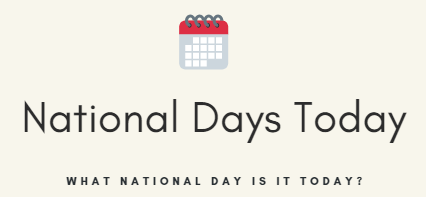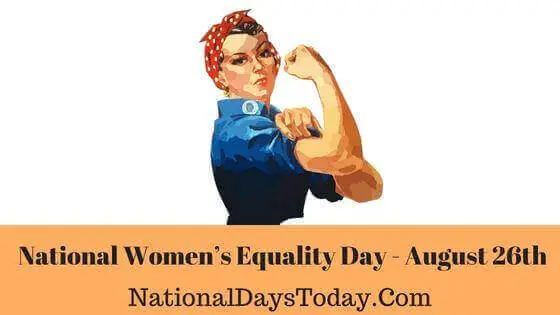National Women’s Equality Day
National Women’s Equality Day:
In 1878, the resolution was originally proposed. The United States Congress declared August 26 as Women’s Equality Day in 1971.
| Year | Date | Day | Where |
| 2023 | 26th August | Saturday | United States |
| 2023 | 26th August | Monday | United States |
| 2025 | 26th August | Tuesday | United States |
Twitter Hashtags:
#NationalWomen’sEqualityDay
#Women’sEqualityDay
Related: Other National Days Celebrated on August 26th
Why National Women’s Equality Day?
Women in the United States have struggled tirelessly to achieve full citizenship rights and benefits, whether public or private, legal or institutional.
Verily, women throughout each state and from every cultural and religious background fought for women’s right to vote, and ,In honor of the passage of the Nineteenth Amendment, Congress has designated August 26 as Women’s Equality Day.
Whereas, establishing Women’s Equality Day as a national holiday shows the importance of women’s contributions to democratic republic,
In the United States, women have fought for full rights and benefits – publicly or privately, legal or institutional – for decades.
How Can We Observe Women’s Equality Day?
Women’s Equality Day is all about recognizing and supporting women, as well as marveling at how they have overcome obstacles and inequality. Men and women show their appreciation for important women in their lives, support local businesses run by women, and celebrate femininity with your woman crew and special women are all popular traditions.
Women ’s education charities and organizations take pleasure in the funds generated. On many virtual and real platforms, outstanding girls are given as guest speakers.
Learn about the women’s fight for civil rights as well as the nineteenth century. examine Susan B. Anthony and Elizabeth Cady libber Remove any from history and research advocacy actions in your own state. Study Carrie Chapman Catt, Lucy Stone, or libber.
On social media, the hashtag #WomensEqualityDay is used to highlight success stories. The internet community conveys information that women face and provides solutions and support.
Interesting facts of National Women’s Equality Day:
Women’s Equality Day was established when Parliament accepted Congresswoman Bella Abzug’s (D-NY) request for a special day to mark the ratification of the 19th Amendment, which ensured that American citizens would not even be denied rights based on their gender.
When the American women’s liberation movement began in 1848, at a convention in Seneca Falls, New York, the leadership who set the country on the route to the 19th Amendment were also concerned about those concerns.
“The Seneca Falls demanded a wide range of rights in 1848, including education, equal opportunity, access to excellent jobs, property ownership independence, and equal protection.” “[The right to vote] was just one of numerous rights for women in 1848,” according to Lange.
The National Woman’s Rights Conference was established in 1850 as a national convention for the proper discussion of women’s rights. Equal salaries, professional rights, property rights, marriage reform, and democracy were all considered throughout the next decade.
In 1921, American author Edith Wharton became the first woman to win the Nobel Prize for literature with her work The Age of Innocence.
Margaret Sanger establishes America’s first birth control clinic in Brooklyn, which would later become Planned Parenthood.
History of National Women’s Equality Day:
Betty Friedan and the National Organization for Women launched a countrywide Women’s Strike for Equality on August 26th, 1970, fifty years later. Women from all political parties banded together to request equal job and educational opportunities, as well as 24-hour childcare centers. This was the ‘significance for gender equality in US history.
In the early nineteenth century, American women began gathering to seek political rights and representation since they couldn’t inherit property and were paid half as much as males in any viable employment.
As the revolution swept the globe in the early 1900s, numerous countries, notably Finland, New Zealand, and the United Kingdom, authorized women’s voting. The 19th Amendment states Government was initially proposed in 1878, but it did not acquire traction. Women’s suffrage did not acquire significant support until their engagement in the World War I fight made their contributions brutally clear. Women’s rights organizations have criticized the duplicity of supporting democracy in Europe while restricting it to half of Americans at home.
The 19th Amendment had to be ratified by 36 states before it could become law, because a federal constitution considered necessary the assent of two-thirds of the states. Harry T. Burn, a teenage state legislator whose mother’s request to embrace the amendment proved a crucial factor in his vote in the Tennessee house of representatives, cast the deciding vote.
Women’s financial situation is still impacted by the salary disparity between men and women, and employment and commercial transactions are still plagued by gender discrimination.


